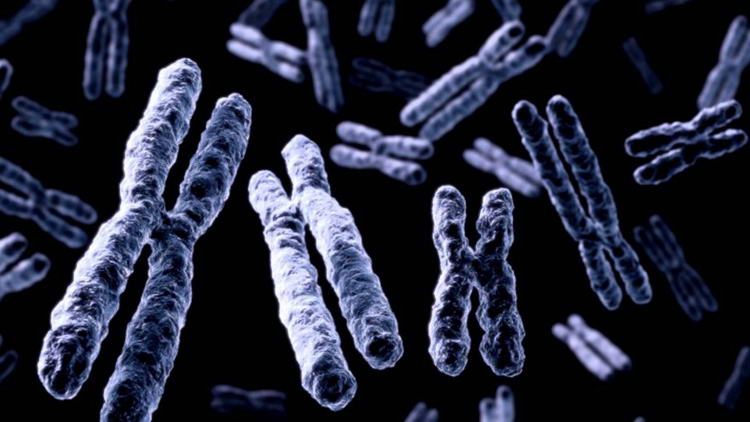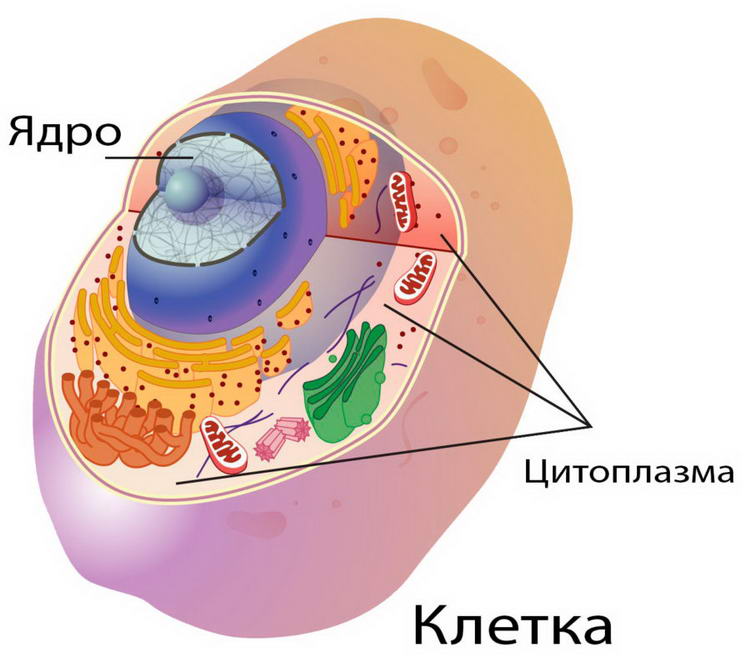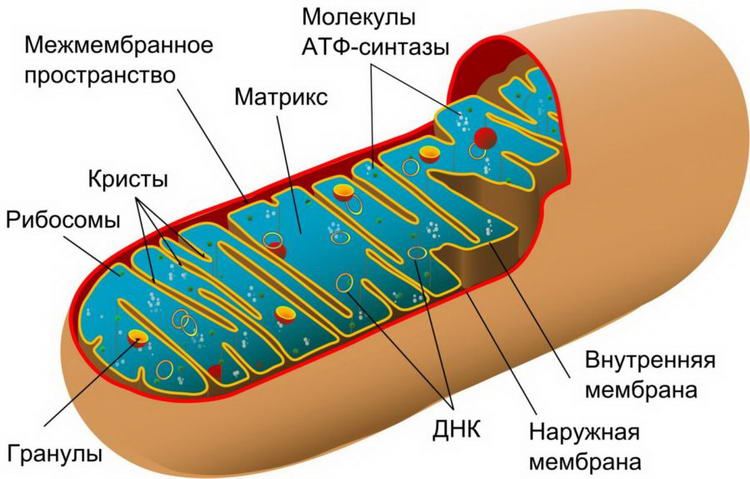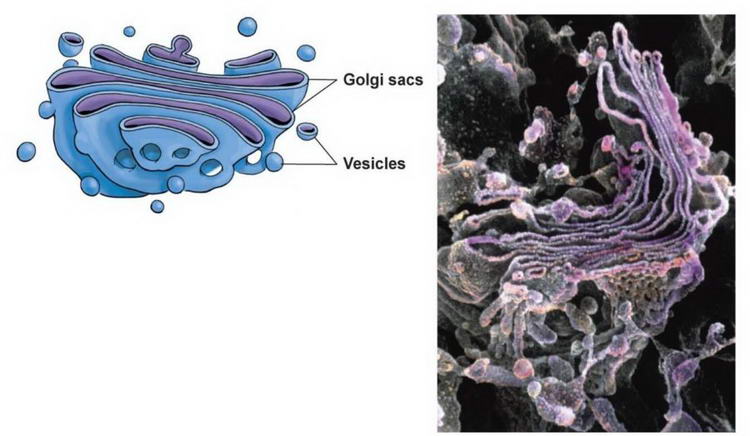Structures of a living cell
Animal and plant cells, both multicellular and unicellular, are in principle similar in structure. Differences in the details of the structure of cells are associated with their functional specialization.
The main elements of all cells are the nucleus and cytoplasm. The nucleus has a complex structure that changes at different phases of cell division, or cycle. The nucleus of a nondividing cell occupies approximately 10–20% of its total volume. It consists of a karyoplasm (nucleoplasm), one or more nucleoli (nucleolus) and a nuclear envelope. Karyoplasm is a nuclear juice, or karyolymph, in which there are chromatin threads that form chromosomes.

The main properties of the cell:
- metabolism
- sensitivity
- ability to reproduce
The cell lives in the internal environment of the body - blood, lymph and tissue fluid. The main processes in the cell are oxidation, glycolysis - the breakdown of carbohydrates without oxygen. Cell permeability is selective. It is determined by the reaction to high or low salt concentration, phago- and pinocytosis. Secretion - the formation and secretion by cells of mucus-like substances (mucin and mucoids), which protect against damage and participate in the formation of intercellular substance.
Types of cell movements:
- amoeboid (false legs) - leukocytes and macrophages.
- sliding - fibroblasts
- flagellate type - spermatozoa (cilia and flagella)
Cell division:
- indirect (mitosis, karyokinesis, meiosis)
- direct (amitosis)
During mitosis, the nuclear substance is distributed evenly between the daughter cells, because The chromatin of the nucleus is concentrated in chromosomes, which split into two chromatids, diverging into daughter cells.
Structures of a living cell
Chromosomes

Mandatory elements of the nucleus are chromosomes that have a specific chemical and morphological structure. They take an active part in the metabolism in the cell and are directly related to the hereditary transmission of properties from one generation to another. However, it should be borne in mind that, although heredity is ensured by the whole cell as a single system, nuclear structures, namely chromosomes, occupy a special place in this. Chromosomes, unlike cell organelles, are unique structures characterized by a constant qualitative and quantitative composition. They cannot interchange each other. An imbalance in the chromosome set of a cell ultimately leads to its death.
Cytoplasm

The cytoplasm of a cell exhibits a very complex structure. The introduction of the technique of thin sections and electron microscopy made it possible to see the fine structure of the underlying cytoplasm. It has been established that the latter consists of parallel arranged complex structures in the form of plates and tubules, on the surface of which there are the smallest granules with a diameter of 100–120 Å. These formations are called the endoplasmic complex. This complex includes various differentiated organelles: mitochondria, ribosomes, the Golgi apparatus, in the cells of lower animals and plants - the centrosome, in animals - lysosomes, in plants - plastids. In addition, a number of inclusions are found in the cytoplasm that take part in the metabolism of the cell: starch, fat droplets, urea crystals, etc.
Membrane
The cell is surrounded by a plasma membrane (from Latin "membrane" - skin, film). Its functions are very diverse, but the main one is protective: it protects the internal contents of the cell from the effects of the external environment. Due to various outgrowths, folds on the surface of the membrane, the cells are firmly interconnected. The membrane is permeated with special proteins through which certain substances necessary for the cell or to be removed from it can move. Thus, the exchange of substances is carried out through the membrane. Moreover, what is very important, substances are passed through the membrane selectively, due to which the required set of substances is maintained in the cell.
In plants, the plasma membrane is covered on the outside with a dense membrane consisting of cellulose (fiber). The shell performs protective and supporting functions. It serves as the outer frame of the cell, giving it a certain shape and size, preventing excessive swelling.
Core
Located in the center of the cell and separated by a two-layer membrane. It has a spherical or elongated shape. The shell - the karyolemma - has pores necessary for the exchange of substances between the nucleus and the cytoplasm. The contents of the nucleus are liquid - karyoplasm, which contains dense bodies - nucleoli. They are granular - ribosomes. The bulk of the nucleus - nuclear proteins - nucleoproteins, in the nucleoli - ribonucleoproteins, and in the karyoplasm - deoxyribonucleoproteins. The cell is covered with a cell membrane, which consists of protein and lipid molecules having a mosaic structure. The membrane ensures the exchange of substances between the cell and the intercellular fluid.
EPS
This is a system of tubules and cavities, on the walls of which there are ribosomes that provide protein synthesis. Ribosomes can also be freely located in the cytoplasm. There are two types of ER - rough and smooth: on the rough ER (or granular) there are many ribosomes that carry out protein synthesis. Ribosomes give membranes a rough appearance. Smooth ER membranes do not carry ribosomes on their surface; they contain enzymes for the synthesis and breakdown of carbohydrates and lipids. Smooth EPS looks like a system of thin tubes and tanks.
Ribosomes
Small bodies with a diameter of 15–20 mm. Carry out the synthesis of protein molecules, their assembly from amino acids.
Mitochondria

These are two-membrane organelles, the inner membrane of which has outgrowths - cristae. The contents of the cavities is the matrix. Mitochondria contain a large number of lipoproteins and enzymes. These are the energy stations of the cell.
Plastids (peculiar to plant cells only!)
Their content in the cell is the main feature of the plant organism. There are three main types of plastids: leucoplasts, chromoplasts, and chloroplasts. They have different colors. Colorless leukoplasts are found in the cytoplasm of the cells of the unstained parts of plants: stems, roots, tubers. For example, there are many of them in potato tubers, in which starch grains accumulate. Chromoplasts are found in the cytoplasm of flowers, fruits, stems, and leaves. Chromoplasts provide the yellow, red, orange color of plants. Green chloroplasts are found in the cells of leaves, stems, and other plant parts, as well as in a variety of algae. Chloroplasts are 4-6 µm in size and often have an oval shape. In higher plants, one cell contains several dozen chloroplasts.
Green chloroplasts are able to transform into chromoplasts, which is why leaves turn yellow in autumn, and green tomatoes turn red when ripe. Leukoplasts can turn into chloroplasts (greening of potato tubers in the light). Thus, chloroplasts, chromoplasts and leukoplasts are capable of mutual transition.
The main function of chloroplasts is photosynthesis, i.e. in chloroplasts in the light, organic substances are synthesized from inorganic ones by converting solar energy into the energy of ATP molecules. Chloroplasts of higher plants are 5-10 microns in size and resemble a biconvex lens in shape. Each chloroplast is surrounded by a double membrane with selective permeability. Outside, there is a smooth membrane, and the inside has a folded structure. The main structural unit of the chloroplast is the thylakoid, a flat two-membrane sac that plays a leading role in the process of photosynthesis. The thylakoid membrane contains proteins similar to mitochondrial proteins that are involved in the electron transfer chain. The thylakoids are arranged in stacks resembling stacks of coins (from 10 to 150) and called grana. Grana has a complex structure: in the center is chlorophyll, surrounded by a layer of protein; then there is a layer of lipoids, again protein and chlorophyll.
Golgi complex

This system of cavities delimited from the cytoplasm by a membrane can have a different shape. The accumulation of proteins, fats and carbohydrates in them. Implementation of the synthesis of fats and carbohydrates on membranes. Forms lysosomes.
The main structural element of the Golgi apparatus is a membrane that forms packages of flattened cisterns, large and small vesicles. The cisterns of the Golgi apparatus are connected to the channels of the endoplasmic reticulum. Proteins, polysaccharides, fats produced on the membranes of the endoplasmic reticulum are transferred to the Golgi apparatus, accumulated inside its structures and “packed” in the form of a substance ready either for release or for use in the cell itself during its life. Lysosomes are formed in the Golgi apparatus. In addition, it is involved in the growth of the cytoplasmic membrane, for example, during cell division.
Lysosomes
Bodies separated from the cytoplasm by a single membrane. The enzymes contained in them accelerate the reaction of splitting complex molecules into simple ones: proteins to amino acids, complex carbohydrates to simple ones, lipids to glycerol and fatty acids, and also destroy dead parts of the cell, whole cells. Lysosomes contain more than 30 types of enzymes (substances of a protein nature that increase the rate of a chemical reaction by tens and hundreds of thousands of times) that can break down proteins, nucleic acids, polysaccharides, fats and other substances. The breakdown of substances with the help of enzymes is called lysis, hence the name of the organoid. Lysosomes are formed either from the structures of the Golgi complex, or from the endoplasmic reticulum. One of the main functions of lysosomes is participation in the intracellular digestion of nutrients. In addition, lysosomes can destroy the structures of the cell itself when it dies, during embryonic development, and in a number of other cases.
Vacuoles
They are cavities in the cytoplasm filled with cell sap, a place of accumulation of reserve nutrients, harmful substances; they regulate the water content in the cell.
Cell Center
It consists of two small bodies - centrioles and centrosphere - a compacted area of the cytoplasm. Plays an important role in cell division
Organelles of cell movement
- Flagella and cilia, which are cell outgrowths and have the same structure in animals and plants
- Myofibrils - thin threads more than 1 cm long with a diameter of 1 micron, arranged in bundles along the muscle fiber
- Pseudopodia (perform the function of movement; due to them, muscle contraction occurs)
Similarities between plant and animal cells
The features that plant and animal cells are similar to include the following:
- A similar structure of the structure system, i.e. the presence of a nucleus and cytoplasm.
- The exchange process of substances and energy is similar in principle of implementation.
- Both animal and plant cells have a membrane structure.
- The chemical composition of cells is very similar.
- In plant and animal cells, there is a similar process of cell division.
- The plant cell and the animal have the same principle of transmitting the code of heredity.

Significant differences between plant and animal cells
In addition to the general features of the structure and vital activity of plant and animal cells, there are special distinctive features of each of them.
Thus, we can say that plant and animal cells are similar to each other in the content of some important elements and some life processes, and also have significant differences in structure and metabolic processes.
